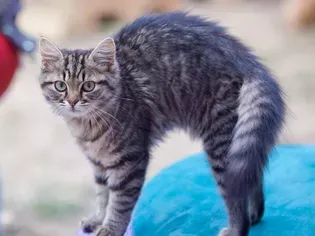Feline Hyperesthesia Syndrome (FHS) in Cats
Updated on 04/26/24

Unveiling the Enigma of Feline Hyperesthesia Syndrome (FHS) in Cats
In the realm of feline health, there exists an enigmatic condition that has puzzled veterinarians and cat owners alike – Feline Hyperesthesia Syndrome (FHS). Characterized by its baffling combination of neurological and behavioral symptoms, FHS can be a perplexing and challenging ailment to manage. This comprehensive guide will delve into the complexities of FHS, shedding light on its causes, symptoms, diagnosis, and treatment strategies.
Unraveling the Causes of FHS
The etiology of FHS remains shrouded in mystery, but several theories have emerged to explain its enigmatic nature. Some experts speculate that FHS may stem from sensory imbalances or hypersensitivity within the central nervous system, leading to an exaggerated response to seemingly innocuous stimuli. Others suggest that it could be a manifestation of an underlying medical condition, such as allergies, gastrointestinal issues, or endocrine disorders.
Recognizing the Signs: A Symptomatic Mosaic
FHS manifests itself through a kaleidoscope of symptoms, including:
* Rippling Skin: This is one of the most characteristic signs of FHS. The cat's skin along the back, tail base, or sides may appear to ripple or twitch spontaneously, often accompanied by a distinctive "rolling" motion.
* Tail-Chasing and Aggression: Some cats with FHS exhibit compulsive tail-chasing behaviors, often accompanied by lashing out, biting, or hissing. These aggressive outbursts may be triggered by seemingly innocuous stimuli, such as petting or brushing.
* Unusual Vocalizations: Cats with FHS may make peculiar vocalizations, ranging from high-pitched yelps to mournful cries. These vocalizations can occur during episodes of skin rippling or seemingly at random.
* Neurological Signs: In severe cases, FHS can manifest with neurological symptoms, such as tremors, ataxia (difficulty walking), or seizures. These neurological manifestations can be particularly concerning and require prompt veterinary attention.
Differentiating FHS from Other Conditions
Due to its multifaceted symptoms, FHS can sometimes be mistaken for other feline ailments. However, a comprehensive medical examination, coupled with the exclusion of other potential causes, can help veterinarians arrive at an accurate diagnosis. It is crucial to rule out conditions such as allergies, skin infections, and neurological disorders to ensure appropriate treatment.
Treating FHS: Managing the Enigma
There is no definitive cure for FHS, but a comprehensive management strategy can help alleviate symptoms and improve the cat's quality of life. Treatment approaches typically involve a combination of therapies:
* Environmental Modification: Reducing potential triggers in the cat's environment can be beneficial. This may include minimizing stress factors, providing ample hiding places, and avoiding overstimulation.
* Medication: Anti-anxiety medications, such as gabapentin or amitriptyline, can help calm the cat's nervous system and reduce episodes of skin rippling and aggression.
* Dietary Management: Some cats with FHS may benefit from a specialized diet that eliminates potential allergens or addresses underlying gastrointestinal sensitivities.
* Behavioral Therapy: A certified animal behaviorist can provide valuable guidance on modifying the cat's behavior and reducing episodes of tail-chasing and aggression.
Prognosis and Living with FHS
The prognosis for cats with FHS varies depending on the severity of the condition. With proper management, many cats with FHS can live relatively normal lives. It is important to be patient and understanding, as resolving this enigmatic syndrome requires a multifaceted approach and ongoing support.
Unveiling the Mystery: Case Studies
To illustrate the complexities of FHS, consider these compelling case studies:
* Case 1: Bella, a 5-year-old Siamese cat, presented with severe rippling skin along her back and tail. She would frequently chase her tail and attack her owners without provocation. After extensive testing ruled out other medical conditions, Bella was diagnosed with FHS. A combination of gabapentin and environmental modification significantly reduced her symptoms, improving her quality of life.
* Case 2: Max, a 2-year-old Domestic Shorthair cat, exhibited intermittent episodes of tail-chasing and aggression. His symptoms were less severe than Bella's, and after a thorough medical examination, he was diagnosed with FHS. Dietary management, combined with behavioral therapy, effectively controlled his symptoms, allowing him to live a happy and fulfilling life.
Conclusion
Feline Hyperesthesia Syndrome is a challenging but manageable condition that requires an understanding of its enigmatic nature and a comprehensive approach to treatment. By recognizing the symptoms, excluding other potential causes, and implementing appropriate management strategies, cat owners can help their feline companions navigate the complexities of FHS and live healthier, happier lives.
Explore More Pets

Cat Behavior Problems
How to Stop Aggression in Kittens

Long-Haired Cat Breeds
Siberian Cat: Breed Profile, Characteristics, & Care

Cat Behavior Problems
How to Stop Kittens From Scratching and Biting

Long-Haired Cat Breeds
Turkish Angora: Cat Breed Profile, Characteristics & Care

Basic Training
How to Socialize Your Kitten

Short-Haired Cat Breeds
Cute Pictures & Facts About Calico Cats & Kittens

Litter Box Training
Training Your Kitten to Use the Litter Box

Long-Haired Cat Breeds
10 Fun Facts About White Cats